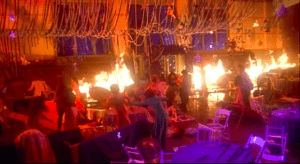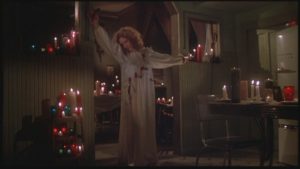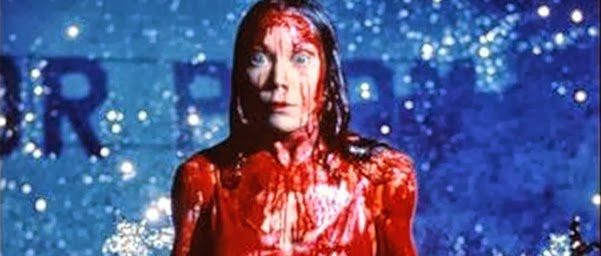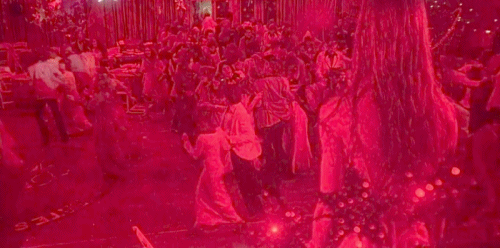What an honor to be able to write this article celebrating the 45th anniversary of Brian De Palma’s iconic Carrie. I jumped at the opportunity. However, when I realized the responsibility I had to represent the film in a way that would do it justice… well, I was a bit overwhelmed. Carrie is such a legendary, beloved, classic film to all of us genre lovers, based on the first book released by Master of Horror Stephen King in 1975, and I want to celebrate it in a way that is truly deserving.
Directed by De Palma from a screenplay written by debut screenwriter Lawrence D. Cohen, Carrie brought us a bit of horror and magic, but at its heart, it’s a revenge film…. a bloody, fiery, satisfying as Hell revenge film. For all of us who have been bullied, abused, oppressed, left out or overlooked, Carrie gave us powers unmatched by any of our enemies.
Carrie was released by United Artists On November 16, 1976, and stars Sissy Spacek (Coal Miner’s Daughter 1980) as our creepy, soft-spoken hero, Nancy Allen (Poltergeist 3 1988) as Chris, classic school bitch and head of the mean girls, PJ Soles (Halloween 1978) as Norma, Chris’s obnoxious sidekick, John Travolta (Grease 1978) as Billy, Chris’s douchebag boyfriend, Amy Irving (The Rage: Carrie 2 1999) as classmate Sue Snell, and William Katt (House 1985) as Tommy, Sue’s boyfriend and Carrie’s ill-fated prom date. Betty Buckley (Split 2016) stars as the school gym teacher, Mrs. Collins, who really tries to find justice for Carrie, and finally, Piper Laurie (The Faculty 1998) who is outstanding in the role of Carrie’s abusive, religious fanatic monster of a mother, Margaret White.

The setting is mainly at Bates High School (yes, it was named after Psycho‘s Norman Bates), and senior prom is swiftly approaching. One may remember the opening sequence to be the locker room scene with a soft, haunting melody complimenting the soft mist of steam twirling around the laughing teenagers as they shower after gym class. This is the scene that sets the tone for the film. The camera cuts slowly through the crowd toward one of the open showers, where pale, skinny, naked, crying Carrie cowers in the corner of the white-tiled stall, covered in her own menstrual blood. Carrie is completely unaware what is happening. The girls realize what is going on and, instead of being sympathetic, they begin laughing and yelling, “Plug it up!” as they throw tampons and Maxi pads at a terrified Carrie. Miss Collins breaks her way through the crowd and runs to the girl, unsure of what is happening, and slaps the hysterical girl in an attempt to calm her down. Miss Collins later admits to the school principal that she could understand why the girls were taunting Carrie: “What kind of a teenage girl doesn’t know about periods?”
However, this is not the opening scene. The film officially starts during a gym volleyball game. Carrie is timid and unsure on her feet. Terrified of the ball, she isn’t exactly a star athlete. This prompts school asshole, Chris, to corner Carrie after the game. “Eat shit!” Chris says angrily. The abuse and vitriol over a simple volleyball game is heart-wrenching to say the least, and throughout the movie, we see examples of how shabbily Carrie is treated by her peers. Graffiti on the walls exclaims, “Carrie White eats shit,” the principal being unable to remember her name, a young boy on a bicycle yelling, “Creepy Carrie!” at her as he rides past, and the constant laughter and whispering everywhere she goes. Sissy Spacek really delivers the impact of this abuse, as Carrie appears meek, vulnerable, unconfident, but quite sweet. https://www.youtube.com/watch?v=YuO26oJQLVs However, Carrie is discovering something about herself, that she has the ability to make things happen with her mind. When her emotions become explosive, she can break objects, throw them across the room, or even make taunting little boys to fall off their bikes.
Now, let’s jump to the Prom scene, the culmination of Carrie’s pain, anger, embarrassment, and the ultimate taking of her own power and self.

“They’re all gonna laugh at you!”
Carrie’s mothers words repeat in her head as, soaked in pig’s blood, she peers out at the laughing faces of her classmates and teachers. This is where things really get good, and all of Carrie’s lifelong suffering explodes into a telekinetic rage. Doors slam, pipes burst, and electricity jumps from live wires to flammable objects. The school burns to the ground in what may possibly be the most famous revenge scene in horror movie history. Almost the entire senior class is trapped inside besides Sue Snell, who sacrificed her evening for Carrie’s happiness. Not even Carrie’s protective and nurturing gym teacher is spared. Carrie is simply blinded by her rage—or does she even know what she is doing? We can truly feel her conflagration of emotion as she walks slowly through the screaming crowd, dripping in pig’s blood, her classmates screaming in terror and pain around her. Carrie had been such a tolerant and sweet girl, but now, she is finally snapping. I can’t help but wonder if the shower of pig’s blood is to mimic the shower scene where Carrie is terrified of her own body and of the blood? In the conclusion, Carrie has embraced what her body can do and becomes motivated to take revenge against those that have wronged her. She takes control of Chris and Billy’s car, terrifying them before causing it to explode and killing them both.

In one final attempt to find solace in her insane and abusive mother, Carrie meets her fate. She does get the last word when she uses her last bit of energy to return the favor. She murders the symbol of her oppression—not her mother, but religion. I understand saying this is controversial, but extreme religion can be oppressive and sometimes even responsible for women’s lives lost throughout history. I feel Carrie is ultimately a revenge film yes, but also a feminist film when women can relate these scenarios.

Interestingly enough, Stephen King had actually thrown away his original scribblings for the idea behind Carrie. It was King’s wife, Tabitha, that inspired him to retrieve the pages, telling him she would help him with the thought process of a teenage girl. It’s a good thing she did, because the movie version of his book was an instant hit, grossing over $33 million and putting King on the map as a horror legend. Piper Laurie and Sissy Spacek were both nominated for Academy Awards for their performances which is extremely rare for a horror movie, let alone a one made in 1976.
I also love the movie’s score, which was created by composer Pino Donnagio, who does a wonderful job of creating the mood for various sequences of Carries, and went on to compose the music for many of De Palma’s films. Since its release, Carrie has become an undoubted staple in horror movie history, inspiring a sequel, The Rage: Carrie 2, in 1999, and a remake, Carrie, in 2013. Hpwever, neither films fared as well as the original.

Some examples of the film’s pop-culture influence and timelessness include the prom scene in Hole’s 1994 music video, “Miss World.” Legendary drag queen Jackie Beat, what has a room in her home dedicated to the film, has said, “Whenever people ask why I love [Carrie] so much, I tell them it’s because the message of the movie is ‘Don’t mess with the freak’.”
Don’t mess with the freak! A simple but powerful message from a simple but powerful horror movie. It’s a message that resonates with all of us who have felt like Carrie: unattractive, vulnerable, terrified of our own body’s capabilities. In the end, that power of emotion can be our undoing… or our uprising.
Forty-five years after Carrie‘s release, we still feel connected, inspired, and fascinated by it. I feel we will still be celebrating Carrie for another 45 years to come. It is that entwined in horror culture, pop culture, and the long-living culture of teenage angst.
 PopHorror Let's Get Scared
PopHorror Let's Get Scared





